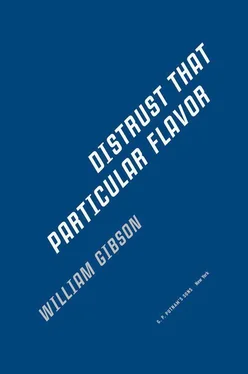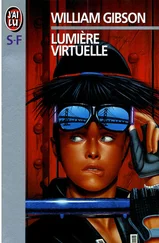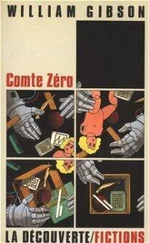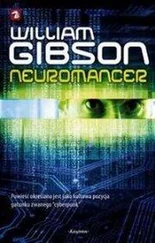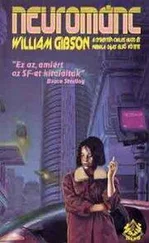These are not observations that one could arrive at using any previous literary model of metropolitan history, but the result of a genuinely postmodern agenda, an entirely new and utterly compelling way to write about cities.
If you wish to possess the world’s greatest city, read this book. If you would learn to expose the soul of a place, in the deepest and most thoroughly contemporary way, read it again.

I loved The Whole Earth Catalog, in the Seventies, though it made me feel guilt. I loved it for the sense it gave that my generation might find new ways of sorting out the world’s difficulties (which now seems terribly ironic). The guilt I felt was equally straightforward, and perhaps as fantastic: that I was not repairing an electricity-generating windmill with a Leatherman tool. It made me feel terribly lazy.
When Bruce Sterling guest-edited an issue, many years later, and invited me to contribute, I decided that Peter Ackroyd’s book constituted a tool. It was for me, certainly, in that it eventually contributed to helping me find a way to write fiction set in London, something I’d long wanted to do.
This piece sells Iain Sinclair short, by the way, as he’s subsequently discovered and named, in works such as Hackney, That Rose Red Empire, and Ghost Milk, the real monsters of the twenty-first-century city. He was never at fault; I was merely impatient.

Modern Boys and Mobile Girls
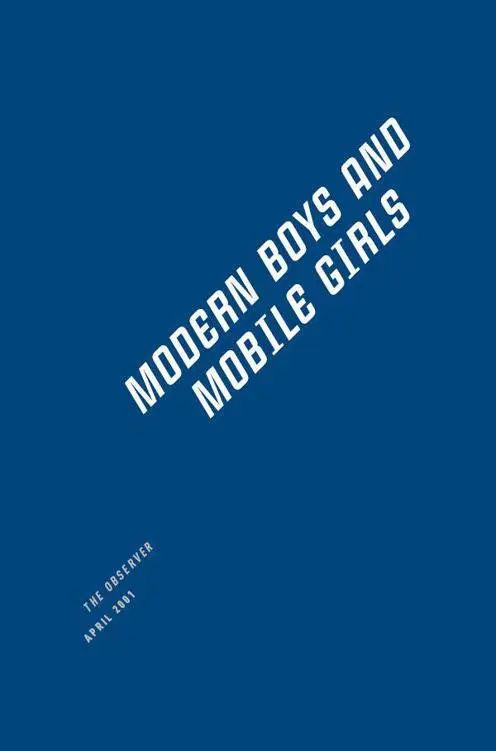
“WHY JAPAN?” I’ve been asked for the past twenty years or so. Meaning: Why has Japan been the setting for so much of my fiction? When I started writing about Japan, I’d answer by suggesting that Japan was about to become a very central, very important place in terms of the global economy. And it did. (Or rather, it already had, but most people hadn’t noticed yet.) A little later, asked the same question, I’d say that it was Japan’s turn to be the center of the world, the place to which all roads lead; Japan was where the money was and the deal was done. Today, with the glory years of the bubble long gone, I’m still asked the same question, in exactly the same quizzical tone: “Why Japan?”
Because Japan is the global imagination’s default setting for the future.
The Japanese seem to the rest of us to live several measurable clicks down the timeline. The Japanese are the ultimate Early Adaptors, and the sort of fiction I write behooves me to pay serious heed to that. If you believe, as I do, that all cultural change is essentially technologically driven, you pay attention to the Japanese. They’ve been doing it for more than a century now, and they really do have a head start on the rest of us, if only in terms of what we used to call “future shock” (but which is now simply the one constant in all our lives).
Consider the Mobile Girl, that ubiquitous feature of contemporary Tokyo street life: a schoolgirl busily, constantly messaging on her mobile phone (which she never uses for voice communication if she can avoid it). The Mobile Girl can convert pad strokes to kanji faster than should be humanly possible, and rates her standing in her cellular community according to the amount of numbers in her phone’s memory. What is it that the Mobile Girls are so busily conveying to one another? Probably not much at all: the equivalent of a schoolgirl’s note, passed behind the teacher’s back. Content is not the issue here, but rather the speed, the weird unconscious surety, with which the schoolgirls of Tokyo took up a secondary feature (text messaging) of a new version of the cellular telephone, and generated, almost overnight, a microculture.
A little over a hundred years ago, the equivalent personal, portable techno-marvel in Tokyo would have been a mechanical watch. The printmakers of the Meiji period made a very large watch the satiric symbol of the westernized dandy, and for the Japanese, clock-time was an entirely new continuum, a new reality.
The techno-cultural suppleness that gives us Mobile Girls today is the result of a traumatic and ongoing temporal dislocation that began when the Japanese, emerging in the 1860s from a very long period of deep cultural isolation, sent a posse of bright young noblemen off to England. These young men returned bearing word of an alien technological culture they must have found as marvelous, as disconcerting, as we might find the products of reverse-engineered Roswell space junk. These Modern Boys, as the techno-cult they spawned came popularly to be known, somehow induced the nation of Japan to swallow whole the entirety of the Industrial Revolution. The resulting spasms were violent, painful, and probably inconceivably disorienting. The Japanese bought the entire train set: clock-time, steam railroads, electric telegraphy, western medical advances. Set it all up and yanked the lever to full on. Went mad. Hallucinated. Babbled wildly. Ran in circles. Were destroyed. Were reborn.
Were reborn, in fact, as the first industrialized nation in Asia. Which got them, not too many decades later, into empire-building expansionist mode, which eventually got them two of their larger cities vaporized, blown away by an enemy wielding a technology that might as well have come from a distant galaxy.
And then that enemy, their conquerors, the Americans, turned up in person, smilingly intent on an astonishingly ambitious program of cultural re-engineering. The Americans, bent on restructuring the national psyche from the roots up, inadvertently plunged the Japanese several clicks further along the timeline. And then left, their grand project hanging fire, and went off to fight Communism instead.
The result of this stupendous triple-whammy (catastrophic industrialization, the war, the American Occupation) is the Japan that delights, disturbs, and fascinates us today: A mirror world, an alien planet we can actually do business with, a future.
But had this happened to any other Asian country, I doubt the result would have been the same. Japanese culture is “coded,” in some wonderfully peculiar way that finds its nearest equivalent, I think, in English culture. And that is why the Japanese are subject to various kinds of Anglophilia, and vice versa. It accounts for the totemic significance, to the Japanese, of Burberry plaid, and for the number of Paul Smith outlets in Japan, and for much else besides. Both nations display a sort of fractal coherence of sign and symbol, all the way down into the weave of history. And Tokyo is very nearly, in its own way, as “echoic” (to borrow Peter Ackroyd’s term) a city as London.
I’ve always felt that London is somehow the best place from which to observe Tokyo, perhaps because the British appreciation of things Japanese is the most entertaining. There is a certain tradition of “Orientalia,” of the faux Oriental that has been present here for a long time, and truly, there is something in the quality of a good translation that can never be captured in the original.
London, being London and whatever else, eminently assured of its ability to do whatever it is that London’s always done, can reflect Japan, distort it, enjoy it, in ways that Vancouver, where I live, never can. In Vancouver, we cater blandly to the Japanese, both to the tour-bus people with the ever-present cameras and to a delightful but utterly silent class of Japanese slackers. These latter seem to jump ship simply to be here, and can be seen daily about the city, in ones and twos, much as, I suspect, you or I might seem to the residents of Puerto Vallarta. “There they are again. I wonder what they might be thinking?”
Читать дальше
